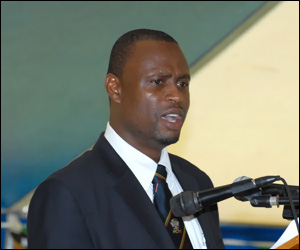
Local Minister For UNESCO – Nigel Carty
Basseterre, St. Kitts – Nevis
March 30, 2013 (SKNIS)
The Inter-Ministerial and Experts Conference on Biosphere Reserves in the Caribbean Sub Region has set a positive tone for Small Island Development States (SIDS) in the region to establish a comprehensive approach on the conservation of sites viable for sustainable development.
Guided by the Conference Subtitle “Tools for Sustainable Development and Growth,” Antonio Maynard, Chairperson and Secretary General of the St. Kitts and Nevis UNESCO National Commission, informed delegates and observers at the Tuesday, March 26 Plenary Session that the two-day Conference was the first of its kind and could be seen as symbolizing the commemoration of the launching of the St. Mary’s Man and Biosphere Reserve (SMBR) which took place April 23, 2012.
Noting the importance of the UNESCO Man and the Biosphere (MAB) Programme, under which SMBR falls, Dr. David Doyle, Permanent Delegate of St. Kitts and Nevis to UNESCO immediately established that SIDS has the opportunity to take advantage of the initiative.
“UNESCO has a very dedicated and focused programme on SIDS which is increasingly being regionalized ““ the proof is in our Conference here today,” Dr. Doyle emphasized. “Not only is it regionalized but decentralized, and increasingly based ““ as you will see on the MAB concept, that is, a consensus-driven approach. In other words, it is a tripartite approach where UNESCO sits on the top but works very closely with the local community, the local government in taking forward these activities.”
Local Minister responsible for UNESCO Honourable Nigel Carty remarked that he was proud to launch the Inter-ministerial Conference noting that the UNESCO assessment of SMBR was justified.
“UNESCO experts were not wrong when they say that St. Kitts MAB Site could serve as a example and inspiration for the wider English-speaking region in addressing our collective cross-cutting national objectives,” Minister Carty noted. “These are intimately linked to the four dimensions of sustainable development namely: economy, ecological, political and cultural sustainability.”
SMBR Community Member and Chairperson of the Conference Steering Committee Telca Wallace gave a detailed overview of the SMBR, explaining that it consists of a core zone which is devoted to the long term protection and conservation, a buffer zone where activities compatible with the core area can take place and a transition area where sustainable resource management practices are promoted and developed.
Mrs. Wallace informed that the local MAB Committee conducted several assessment and information-gathering sessions including hikes into prospective eco-tourism areas, including a former Maroon settlement.
“On one of our trips we went out to do an assessment of the Cayon Waterway,” Mrs. Wallace explained. “We went way up ““ it was challenging, but we got there. We went to the same Maroon “˜Congo Town,’ where it was historically located, and it was very difficult to get there and you realize why the Maroons went there to hide because you would not go there unless you really, really wanted to go there.”
The Inter-ministerial Conference outcomes included the signing of a Ministerial Declaration and a Plan of Action.